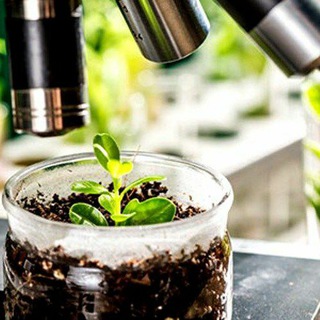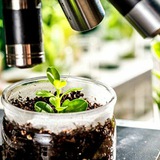Plant Protection science 🌱🦠🔬
#cropprotection
Канал

216
подписчиков
322
фото
45
видео
56
ссылок
کانال علم و دانش گیاهپزشکی
اخبار و تازه های گیاهپزشکی
توسط دانشجویان گیاهپزشکی دانشگاه سراسری تبریز
مطالب علمی مفید
Plant Protection science 🌱🦠🔬
Mode of action labeling as part of IRM strategy 🐛🌿🧪🧑🔬⚛️
Mode of action labeling as part of IRM strategy 🐛🌿🧪🧑🔬⚛️
⚛️Insecticide resistance is a phenomenon where insects, over time, develop the ability to survive exposure to insecticides that were once effective in controlling them.
🐛This can lead to reduced sensitivity of an insect population to an insecticide that is frequently being applied.
🗓️One of the earliest accounts for insecticide resistance in the Philippines is the case of diamond back moth (Plutella xylostella) in cabbage. It is the most important pest of cabbage being cultivated in Benguet, Mt Province, Cebu, Bukidnon and Davao provinces.
🧪In 1974, first report of DBM resistance to mevinphos was reported with multiple resistance to various insecticides was documented in 1976, including insect growth regulators in 1994, fipronil in 2005 and with latest reports on flubendiamide and other diamides in general.
🧬This resistance can occur due to genetic mutations that make the insects less susceptible to the chemicals.
📍When insecticides are used, selection pressure on population happens. Insects that are resistant to the insecticide survive and reproduce, passing on their resistance genes to their offspring.
♻️When a farmer excessively applied insecticide this can accelerate resistance. Using the same insecticide repeatedly can quickly select for resistant individuals.
🧑🔬Insects also develop cross resistance to multiple insecticides that renders similar resistance mechanisms.
🪴Resistance development for insects like DBM can continuously arise in the future since many farmers seldom rotate insecticides with different mode of action (MOA).
🫙As a fact, farmers use insecticides and alternately spraying them based on their brand names or active ingredients. In cypermethrin market alone, there are more than 100 registered brands not to mention other pyrethroids that belong to the same MOA within IRAC Group 3.
🏷️In order to support IRM efforts, MOA icons are now included in the product labels so that farmers can practice MOA rotation.
🚨With this effort, farmers and retailers have access to relevant information on IRM and can decide which products to apply alternately and repetitively within the IRAC recommendations.
💡Mode of action labeling is a valuable tool for promoting the responsible and effective use of pesticides while minimizing the negative impacts on human health, the environment, and the development of resistance in insect populations.
📹Video Credit: https://lnkd.in/gfVZZdps
#innovation #agribusiness #agriculture #agronomy #cropprotection
⚛️Insecticide resistance is a phenomenon where insects, over time, develop the ability to survive exposure to insecticides that were once effective in controlling them.
🐛This can lead to reduced sensitivity of an insect population to an insecticide that is frequently being applied.
🗓️One of the earliest accounts for insecticide resistance in the Philippines is the case of diamond back moth (Plutella xylostella) in cabbage. It is the most important pest of cabbage being cultivated in Benguet, Mt Province, Cebu, Bukidnon and Davao provinces.
🧪In 1974, first report of DBM resistance to mevinphos was reported with multiple resistance to various insecticides was documented in 1976, including insect growth regulators in 1994, fipronil in 2005 and with latest reports on flubendiamide and other diamides in general.
🧬This resistance can occur due to genetic mutations that make the insects less susceptible to the chemicals.
📍When insecticides are used, selection pressure on population happens. Insects that are resistant to the insecticide survive and reproduce, passing on their resistance genes to their offspring.
♻️When a farmer excessively applied insecticide this can accelerate resistance. Using the same insecticide repeatedly can quickly select for resistant individuals.
🧑🔬Insects also develop cross resistance to multiple insecticides that renders similar resistance mechanisms.
🪴Resistance development for insects like DBM can continuously arise in the future since many farmers seldom rotate insecticides with different mode of action (MOA).
🫙As a fact, farmers use insecticides and alternately spraying them based on their brand names or active ingredients. In cypermethrin market alone, there are more than 100 registered brands not to mention other pyrethroids that belong to the same MOA within IRAC Group 3.
🏷️In order to support IRM efforts, MOA icons are now included in the product labels so that farmers can practice MOA rotation.
🚨With this effort, farmers and retailers have access to relevant information on IRM and can decide which products to apply alternately and repetitively within the IRAC recommendations.
💡Mode of action labeling is a valuable tool for promoting the responsible and effective use of pesticides while minimizing the negative impacts on human health, the environment, and the development of resistance in insect populations.
📹Video Credit: https://lnkd.in/gfVZZdps
#innovation #agribusiness #agriculture #agronomy #cropprotection
lnkd.in
LinkedIn
This link will take you to a page that’s not on LinkedIn
How are crop protection products approved?
All countries except Iran
1. Before selling crop protection products, they need to undergo strict evaluation by authorities for each country to ensure that they are safe for humans and have no unacceptable effects on the environment.
2. Hundreds of residue, toxicological, eco-toxicological, environmental, physical-chemical, and efficacy studies.
3. All this scientific information is compiled in a registration dossier, containing individual study reports, summaries and risk assessments, including proposals for risk mitigation.
4. These dossiers are submitted to regulatory authorities around the world who review the submitted data and risk assessments, and grant or deny approval of active substances and products based on their specific regulations and conclusions.
To decide whether a crop protection product is safe, multiple areas are investigated including:-
1. Dietary safety: Evaluates the exposure to the human population, including sensitive populations such as infants and children, from potential residues of chemicals in food and drinking water to ensure the levels are safe.
2. Toxicology: Studies the adverse effects of chemicals in mammals to assess potential effects in humans.
3. Environmental fate: Investigates the behavior, metabolism and distribution of substances in the environment (soil, water, groundwater, air).
4. Environmental effects: Assess the potential effects of chemical or biological agents to non-target organisms in the environment.
5. Occupational exposure: Evaluates exposure to workers resulting from the manufacture and use of chemicals and determines required personal protection equipment to ensure safety.
6. Product chemistry: Determines the physical chemical properties of a chemical (e.g. solubility, volatility, chemical reactivity) that are important to ensure safe storage, transport, use and disposal of a chemical.
7. Agronomic development: Evaluates how a product should be used in the field to ensure maximum efficiency and crop safety.
#innovation #agriculture #cropprotection
All countries except Iran
1. Before selling crop protection products, they need to undergo strict evaluation by authorities for each country to ensure that they are safe for humans and have no unacceptable effects on the environment.
2. Hundreds of residue, toxicological, eco-toxicological, environmental, physical-chemical, and efficacy studies.
3. All this scientific information is compiled in a registration dossier, containing individual study reports, summaries and risk assessments, including proposals for risk mitigation.
4. These dossiers are submitted to regulatory authorities around the world who review the submitted data and risk assessments, and grant or deny approval of active substances and products based on their specific regulations and conclusions.
To decide whether a crop protection product is safe, multiple areas are investigated including:-
1. Dietary safety: Evaluates the exposure to the human population, including sensitive populations such as infants and children, from potential residues of chemicals in food and drinking water to ensure the levels are safe.
2. Toxicology: Studies the adverse effects of chemicals in mammals to assess potential effects in humans.
3. Environmental fate: Investigates the behavior, metabolism and distribution of substances in the environment (soil, water, groundwater, air).
4. Environmental effects: Assess the potential effects of chemical or biological agents to non-target organisms in the environment.
5. Occupational exposure: Evaluates exposure to workers resulting from the manufacture and use of chemicals and determines required personal protection equipment to ensure safety.
6. Product chemistry: Determines the physical chemical properties of a chemical (e.g. solubility, volatility, chemical reactivity) that are important to ensure safe storage, transport, use and disposal of a chemical.
7. Agronomic development: Evaluates how a product should be used in the field to ensure maximum efficiency and crop safety.
#innovation #agriculture #cropprotection
Learn how to recognize the eggs of predatory arthropods employed in augmentative biological control.
Sizes are not scaled -> relative differences in egg size among species are not real.
#biologicalcontrol #ipm #ipmanagement #predators #cropprotection
Sizes are not scaled -> relative differences in egg size among species are not real.
#biologicalcontrol #ipm #ipmanagement #predators #cropprotection
